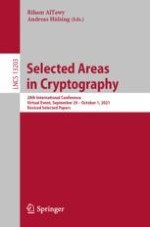This book contains revised selected papers from the 28th International Conference on Selected Areas in Cryptography, SAC 2021, held as a virtual event September and October 2021.*
The 23 full papers presented in this volume were carefully reviewed and selected from 60 submissions. They cover the following research areas: design and analysis of symmetric key primitives and cryptosystems, including block and stream ciphers, hash functions, MAC algorithms, and authenticated encryption schemes, efficient implementations of symmetric and public key algorithms, mathematical and algorithmic aspects of applied cryptology, and secure elections and related cryptographic constructions.
*The conference was originally planned to take place at the University of Victoria, BC, Canada. Due to the COVID-19 pandemic, it was held virtually.
